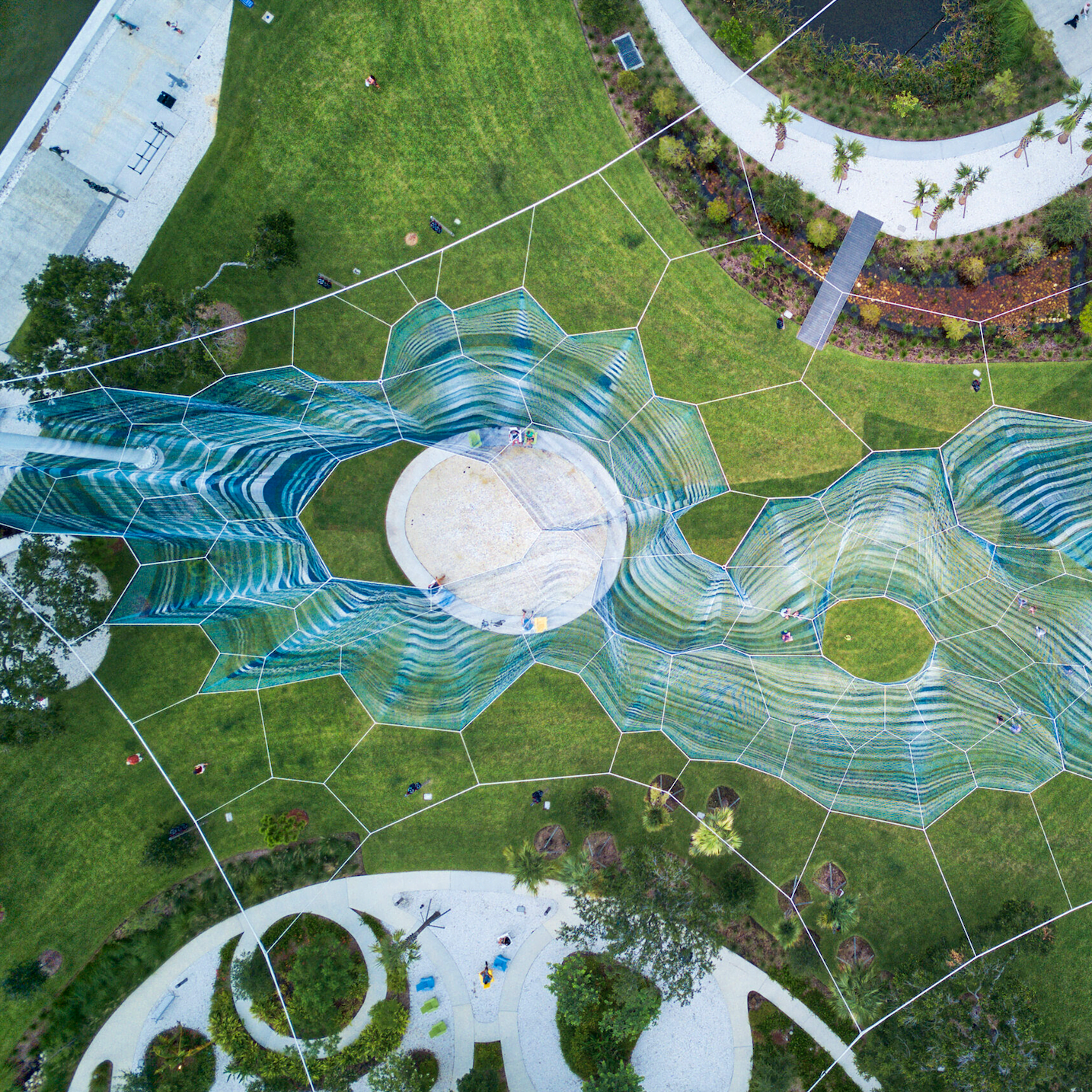On July 6, 2020, the new St. Pete Pier™ and its St. Pete Pier District debuted world-renowned artist Janet Echelman’s latest large-scale aerial sculpture. The work, which was inspired by both the destination and its connection to the Civil Rights Movement, incorporates materials and technology utilized by NASA. Entitled ‘Bending Arc,’ the aerial sculpture is composed of 1,662,528 knots and 180 miles of twine and spans 424 feet, reaching 72 feet at its tallest point. Named an Architectural Digest Innovator for “changing the very essence of urban spaces,” Echelman and her work defy categorization.
Echelman’s artwork offers visitors an oasis where they can seek a moment of calm sensory experience and heightened awareness of nature and our place within it. “The sky is the canvas for my artwork,” says Echelman.
Embracing change, the monumental sculpture gently billows above the Pier District, allowing the wind to create a choreography of constantly changing shape in the sculpture’s soft surface. The sculpture’s color also transforms at every moment while its surface interplays with natural and projected light. In daytime the sculpture casts shadow drawings on the park and people below, and at night it transforms into a glowing beacon of magenta and violet light. Images available here.
How It’s Made
The technical design process utilizes custom proprietary software that allows Echelman’s team to perform soft-body 3D modeling of the monumental design while understanding the constraints of the craft, and shows digital responses to the forces of gravity and wind.
First, the artist extrudes custom color PTFE (Polytetrafluoroethylene) into fiber. PTFE is a highly-engineered technical fiber that retains its strength under UV exposure, and for this reason has historically been used to coat astronauts’ spacesuits.
Then the artist mixes multiple fiber colors together and braids them into twine. The blended colors of twines are wrapped onto bobbins and loaded onto looms which knot lengths of diamond mesh netting. Mesh is hand-cut and hand-knotted together to sculpt complex geometric forms.
Separately, UHMWPE (Ultra-high-molecular-weight polyethylene) fiber is braided into ropes. This fiber is 15 times stronger than steel by weight and was used by NASA to tether the Mars Rover. These ropes are spliced by hand to create the 420 ft rope structure using a method that fishermen and mariners have used for centuries. Then the net is meticulously hand-knotted to the rope structure.
Cranes arrive on site to pull the ropes into tension at maximum force levels of 65 tons at top of masts. The net and rope structure has been engineered by Arup to withstand a design wind load of 150 mph.
The sculpture is illuminated with sustainable low-energy LED lights which project a combination of colors designed by the artist to transform the sculpture at night into a glowing beacon.
About ‘Bending Arc’ and Janet Echelman
The internationally-renowned artist, born and raised along the shores of Tampa Bay, was inspired by historical postcards depicting blue and white striped beach parasols together with the geometric forms made by colonies of barnacles growing on the underside of the pier itself. The sculpture’s design in aerial view can be read as three barnacle-like parasols nestled together.
As she continued her design process, she learned of the site’s important Civil Rights Movement significance, as the place where local citizens began peacefully challenging racial barriers, leading to the 1957 US Supreme Court case ruling which upheld the rights of all citizens to enjoy use of the municipal beach and swimming pool without discrimination. The sculpture’s geometry in section is composed of multiple arcs, which gently billow in the wind. The artist titled the sculpture Bending Arc in reference to MLK’s words: “The arc of the moral universe is long, but it bends toward justice.”
Echelman’s work has been celebrated for enlivening cities and have become focal points for urban life on five continents, from Singapore, Sydney, Shanghai, and Santiago, to Beijing, Boston, New York and London. Her experiential sculptures such as her permanent works in Porto, Vancouver, San Francisco, West Hollywood, Phoenix, Eugene, Greensboro, Philadelphia, and Seattle transform daily with colored light and the natural movement of wind.
About the St. Pete Pier
Janet Echelman was commissioned to create a monumental aerial sculpture for the Pier District which is also receiving multiple accolades for its future-forward design, an ambitious and sustainable infrastructure that not only embraces, but empowers St. Petersburg’s growth. It encompasses many things from economic development, urban resilience and environmental awareness to equity, access, enjoyment and recreation – designed to be as rich in use now as it will be in twenty years, fifty years and beyond.






